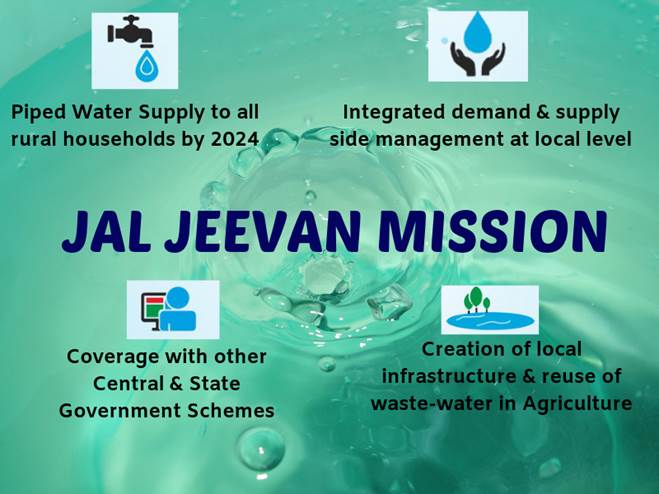Description

Copyright infringement not intended
In News
- Jal Jeevan Mission has achieved a new landmark by providing connection to more than 10 Crore rural households with safe and clean drinking water through taps.
- When the Prime Minister launched the Jal Jeevan Mission on 15th August 2019, only 3.23 Crore of the households in villages had access to piped water connections.
- 3 States (Goa, Telangana and Haryana) and 3 UTs (Puducherry, Dadra & Nagar Haveli and Daman & Diu (D&NH and D&D) and A&N Islands), have reported 100% coverage.
Jal Jeevan Mission
- The Mission was launched on August 15, 2019.
- Implemented by the Ministry of Jal Shakti
- To provide safe and adequate drinking water through household tap connections by 2024 to all rural households and public institutions; Gram Panchayat building, Primary School, Anganwadi centre, Health and wellness centres, etc.
Features
- The Mission ensures community participation and also includes an Awareness, Education and Communication Campaign.
- Development of water supply infrastructure to provide tap water connection to every rural household.
- Development of drinking water sources to ensure the long-term sustainability of the water supply system.
- Other features; Providing training, establishing water quality laboratories, Strict water quality testing and surveillance, Promoting Research work, starting a knowledge centre, a programme for capacity building of communities, etc.
Significance of the Mission
- Jal Jeevan Mission has brought socio-economic benefits to the rural population.
- Regular tap water supply relieves people, especially women and young girls, from carrying heavy bucket loads of water to meet their daily household needs.
- The saved time can be used for income generation activities, learning new skills and supporting children’s education.
Concern
- India has adequate fresh water. The problem is inefficient and wasteful use.
- Law and policy measures to address it remain insufficient. The primary source of domestic water and irrigation is groundwater but the media and policymakers still and often focus on surface water.
- The reason for excessive use of groundwater is the legal framework governing access to the resource; landowners see groundwater as their own and as a resource, they can exploit without considering the need to protect
- The present framework remains mostly top-down and is incapable of addressing local situations adequately.
- Water usage for major crops in India is two to four times that in other large farming nations due to wasteful flood irrigation, mostly in northern India.
- The present subsidy structure “encourages using more inputs such as fertilizer, water and power. Most states provide electricity either for free or at a flat rate. This leads to wasteful water extraction.
- About 80 Crore Indians face water Scarcity and about 2 lakh people die every year due to inadequate access to Safe water.
- The population of India will be more than 1.5 billion people by 2030. Achieving food Security for this rising Population becomes more difficult with water Scarcity.
- No Indian City Supplied 24x7 water to its entire urban Population, and only 35% of urban households in India had piped water.
- Water Shortages Can hamper industrial operations
- Biodiversity is impacted by human activities undertaken to Create additional water Sources. These activities include dam Construction and river diversion which Can lead to Changes in water flow, Salinity levels, and monsoon Patterns.

Steps by the Government for water management
- The government of India launched Jal Shakti Abhiyan with a mission mode approach intended to improve water availability including groundwater conditions in the water-stressed blocks in India.
- National Water Policy (2012) has been formulated by the Department of Water Resources for the conservation of rivers, river bodies and infrastructure in a scientifically planned manner through community participation.
- Central Ground Water Authority has been constituted under the “Environment (Protection) Act, 1986” for regulation and control of groundwater development and management in the Country.
- Master Plan for Artificial Recharge to Groundwater 2020 has been prepared in consultation with States/UTs.
- Construction of watershed management structure under Mahatma Gandhi National Rural Employment Guarantee Scheme.
- Pradhan Mantri Krishi Sinchayee Yojana promotes water conservation and management, water harvesting, soil and moisture conservation, groundwater recharge, flood protection, and land development.
- Atal Bhujal Yojana for sustainable management of groundwater with community participation is being taken up in the identified over-exploited and water-stressed areas in the States of Gujarat, Haryana, Karnataka, Madhya Pradesh, Maharashtra, Rajasthan and Uttar Pradesh.
Way Forward
- Need to adopt innovative approaches to Sustainable Operation and Maintenance. Involve community members at all Stages, and ensure effective Communication among all stakeholders.
- India has one of the largest watershed management programs in the world. This programme will enhance this progress by adopting and applying scientific technologies, decision support tools, and knowledge exchanges.
- Government and administration should work with local communities to revive traditional water bodies, and design and construct cost-effective groundwater recharge structures; such as check dams, ponds, farm ponds, tanks, recharge wells, etc.
- The Water Management program focuses on recharging underground aquifers and promoting rainwater harvesting. This improves the availability and quality of groundwater in the long run and provides water security to all.
https://www.pib.gov.in/PressReleasePage.aspx?PRID=1853125
https://t.me/+hJqMV1O0se03Njk9
















